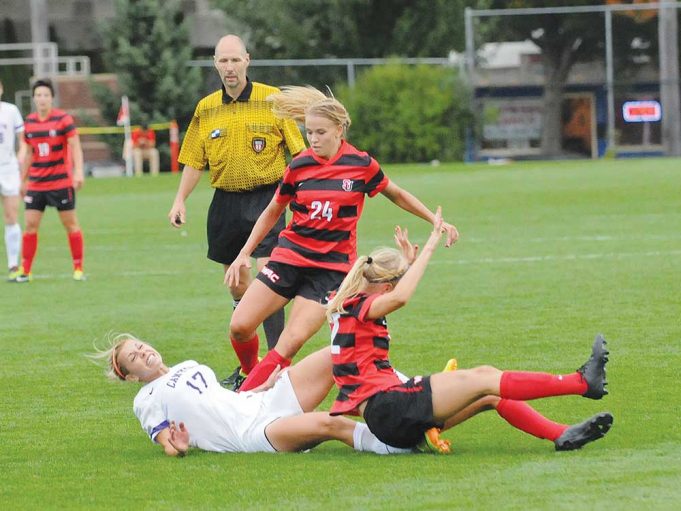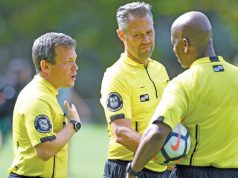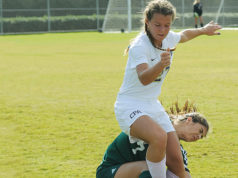When teaching the entry-level referee course, I often noted to students that, although they needed to know that persistent infringement was one of the seven official reasons for a caution, I did not expect any of them to actually give a persistent infringement card until they had been officiating for at least a year or two. Why? Mostly because, until new referees have 100 or so games under their belt, they probably wouldn’t see a case of persistent infringement.
Did that mean it wasn’t happening? No, it simply meant that, for the overwhelming majority of referees in their first several years, they literally can’t perceive it. It takes roughly that amount of time to make the conceptual leap from seeing individual fouls to seeing patterns of fouling behavior. That should not be surprising when you think about it. With all the things going on around you in a soccer game, the initial focus is on individual events — the foul itself — and the immediately important stuff regarding whether it was really an offense, whether you should apply advantage if it was, whether the foul was reckless or excessively forceful or tactical, and how you restarted play if you did blow the whistle.
You may even have noted who did it (number or name or maybe just hair color!) but that information likely was buried under the tons of other stuff you were still struggling with and trying to get right. Then the next foul occurs and the same immediate issues draw your attention. In the process of hoping you got them all right, the identity of the perpetrator and the fact that it was the same person as before just doesn’t register. Occasionally, an experienced assistant referee might clue you in that number 10 had tripped opponents several times, or a player or a coach might offer the helpful suggestion that number 10 had been called several times for holding.
By and large, however, getting the individual foul decisions right demanded all of your attention and there simply wasn’t room in your brain for storing the additional information needed to handle the issue of any patterns in the occurrence of fouls. Until your ability to handle individual fouls correctly becomes second nature, the possibility of patterns would actually be a dangerous distraction.
As you gain experience and confidence, handling the individual fouls becomes easier and you begin seeing a lot of other things going on. They always were there, but now you are seeing them. Don’t beat yourself up — it is a natural development, and it applies not just to fouls but across the board to many other aspects of the game.
What are some of the other things going on that you just don’t see … until you are ready to see them? Here’s one.
Advantage
New referees rarely call advantage. That is a good thing because, frankly, the games assigned to new referees rarely have true advantage situations. It takes a lot of experience before a player would actually be able to overcome the disadvantage of being fouled and a lot of officiating experience to know when an advantage decision would be appropriate. What is even more difficult for a referee is, again, to see it because the application of advantage requires you to put any given foul in the context of what is going on in the larger area around the foul involving the fouled player, the fouled player’s teammates and the fouled player’s opponents.
That doesn’t come easily because, with many new referees being (or having been) active players themselves, their tendency is to focus on the area immediately around the ball and down toward the ground. That works out well for “getting the foul” (particularly lower body fouls), but not so well for “getting the context” and advantage is all about the context.
It is humorous at times watching referees at the cusp of experience where the advantage call possibility is just beginning to dawn on them. You can read their faces as the realization of the advantage decision dawns on them — was it? Yes, it was! What was I supposed to do? I know! Call out “play on!” Oops, too late. I would hazard a guess that, for most officials, the first six advantage decision opportunities are missed, followed by the seventh opportunity when they are now primed and ready for the call, which they make, only to realize that it was the wrong decision!
Teams are greater than the sum of their parts. The new referee’s focus tends to be on individuals, again because the need to get foul decisions right is paramount. And, as with the advantage decision, that is not a bad thing because a new referee’s game assignments tend to involve teams whose level of experience rarely rises above undifferentiated bodies running all over the place interchangeably (sometimes even including the goalkeeper!). Accordingly, there is little reason to pay particular attention to either specific talents (because they rarely exist) or to cooperative behavior (because the players rarely rise above rampant egotism). What is happening “off the ball” is rarely important.
However, with experience and exposure to increasingly competitive play, at some point the realization dawns that, frequently, concerted things are happening that impact significantly on your job and that those other events are scattered about the field. Fortunately, that is often also the point at which we find assistant referees routinely assigned to the match to help with those other areas.
But it still comes down to accepting that you just can’t simply “run with the ball” anymore in order to see what is going on. That is when the concept of “positioning” starts to become important … and when the failure to recognize that positioning is important starts to become dangerous.
It is also when team strategies start to impinge on your awareness. When A3 gets the ball under those conditions, he or she tends to pass it to either teammate A9 or to carry it 10 yards farther along the left wing under those conditions unless opponent B5 is defending down that wing. Previously, a pattern of that sort wasn’t important because it did not appear to have anything to do with a foul in the process of occurring. Now, it is increasingly being seen as a high probability precursor of the foul which you used to just whistle and which now you think might be preventable.
Officiating is a learning experience. All referees need to understand they will see more of what is going on in the game only over time and only as they master the more immediate challenges. It is trite to say that you have to know how to walk before you can run, but it is a lesson that must be learned. It is also why the USSF grades are finely tuned to fit the types of games typically assigned at each level.
It is not an accident that games for grade 9 (recreational) referees rarely have persistent infringement, advantage decision opportunities, role differentiations (other than goalkeeper) or active team strategies. That is where the new referee gets to focus on basics because that is also where the players are being focused by their coaches. It is where the player-learning-to-become-referee gradually transforms into the referee-with-playing-experience.
It is, in short, where the basics can start to become second nature and the referee with greater experience can now begin to expand his or her horizons to see patterns instead of individual events.
What's Your Call? Leave a Comment:
Note: This article is archival in nature. Rules, interpretations, mechanics, philosophies and other information may or may not be correct for the current year.
This article is the copyright of ©Referee Enterprises, Inc., and may not be republished in whole or in part online, in print or in any capacity without expressed written permission from Referee. The article is made available for educational use by individuals.


















